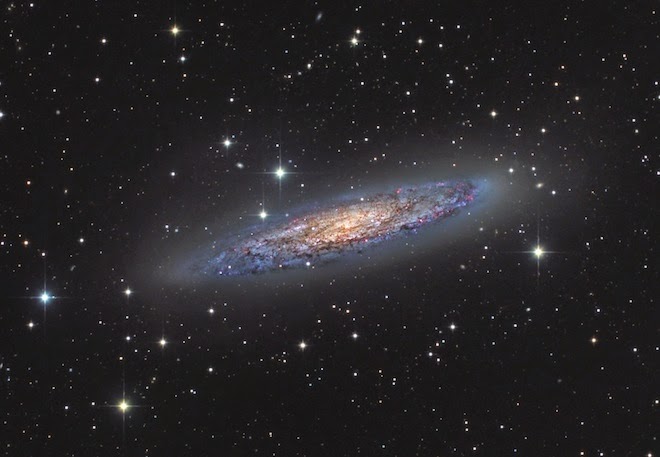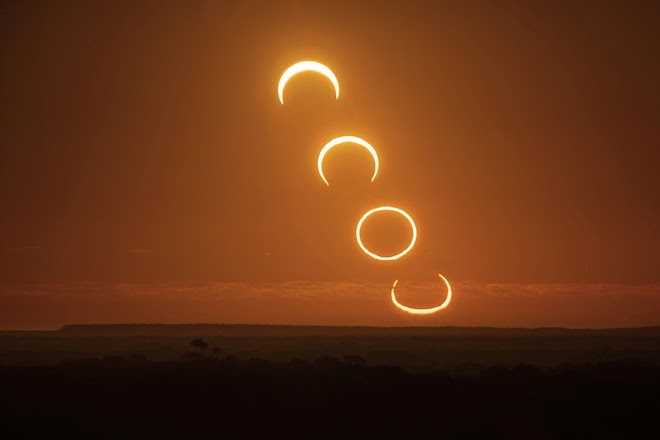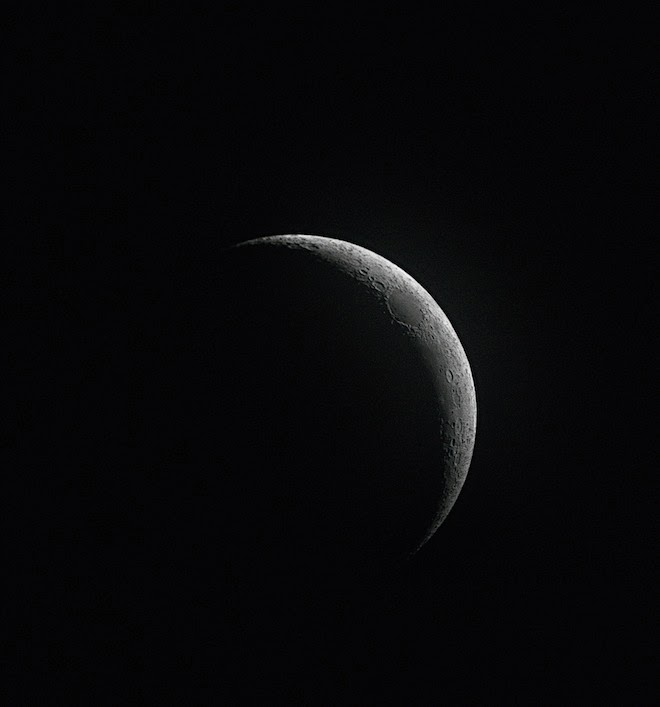It's time once again to "Ooh" and "Ahh" at some of the best images of the night sky taken by amateur astronomers around the world. The Royal Observatory Greenwich announced the winners of its Astronomy Photographer of the Year competition on September 19.
The competition turned five this year and drew more than 1,200 snapshots of space. The winning shot can be seen above. It comes from Australian photographer Mark Gee and shows the Milky Way shining over a rocky shore protected by a lighthouse. He was the winner both in his category, Earth and Space, and the competition's overall winner.
The other categories included Deep Space, Our Solar System, and Young Astronomy Photographer of the Year, which is reserved for budding astrophotographers under the age of 16. A spectacular shot of the Milky Way won this last prize, submitted by 14-year-old Jacob Marchio from the U.S.
There were two special categories this year. People and Space, which asked for images of humans doing one of the things they do best: Staring in wonder at the heavens. Mark Gee won this category as well, with an image of a small crowd framed by the rising moon. And the Sir Patrick Moore prize for Best Newcomer went to Sam Cornwell of the U.K. with a shot of the transit of Venus, which occurred in 2012. There was also the Robotic Scope Image of the Year, won by László Francsics of Hungary for his picture of the Trapezium Cluster.
Guiding Light to the Stars
The skies of the Southern Hemisphere offer a rich variety of astronomical highlights. The central regions of the Milky Way Galaxy, 26,000 light years away, appear as a tangle of dust and stars in the central part of the image. Two even more distant objects are visible as smudges of light in the upper left of the picture. These are the Magellanic Clouds, two small satellite galaxies in orbit around the Milky Way. You can find a larger version of this image here.
Image: Mark Gee (Australia), winner Earth and Space and overall winner
Green Energy
The shifting lights of the Aurora Borealis can take on many shapes and forms as they are moulded by the Earth’s complex magnetic field. Sheets and planes of glowing gas appear to be twisted into a giant vortex above Grøtfjord in Norway.
Image: Fredrik Broms (Norway), runner up Earth and Space
Icy Visitor
Like the snowy mountains in the foreground, the nucleus of Comet Panstarrs is composed largely of ice and rock. The nucleus itself is just a few kilometres across but as it neared the Sun in early 2013, ice evaporating from the surface formed a tail of gas and dust hundreds of thousands of kilometres long.
Image: Fredrik Broms (Norway), highly commended Earth and Space
A Quadruple Lunar Halo
All of the light which reaches the ground from space must first travel through the Earth’s atmosphere. During its journey the light can be altered by all sorts of atmospheric phenomena. Tiny ice crystals high above the ground refract the moonlight diverting it into a number of beautiful haloes.
Image: Dani Caxete (Spain), highly commended Earth and Space
Snowy Range Perseid Meteor Shower
A great deal of careful planning, a long night of photography and hours of painstaking image processing have gone into creating this startling composite image of the Perseid meteor shower. The Perseid meteors get their name from the constellation of Perseus from where they appear to come. However, even at the peak of the shower it is impossible to predict exactly when or where the next meteor will appear. The photographer has combined 23 individual stills to convey the excitement and dynamism of this natural firework display.
Image: David Kingham (USA), highly commended Earth and Space
Celestial Impasto: Sh2-239
Structures like this often seem unchanging and timeless on the scale of a human lifetime. However, they are fleeting and transient on astronomical timescales. Over just a few thousand years the fierce radiation from the stars in this nebula will erode the surrounding clouds of dust and gas, radically altering its appearance.
Image: Adam Block (USA), winner Deep Space
Rho Ophiuchi and Antares Nebulae
The smoky appearance of the dust clouds in this image is fitting, since the grains of dust which make up the nebula are similar in size to particles of smoke here on Earth. The dust can reflect the light of nearby stars, as seen in the blue and yellow regions. It can also block and absorb the light of more distant stars, appearing brown and black in this image. To the right a bright star is ionizing a cloud of hydrogen gas, causing it to glow red, while below it far in the distance, is a globular cluster containing thousands of stars.
Image: Tom O’Donoghue (Ireland), runner up Deep Space
Omega Centauri
Omega Centauri is a globular cluster, a spherical cloud containing several million stars. As this image shows, the stars are more densely clustered towards the centre. The pronounced red colour of several of the stars gives away the cluster’s great age: it is thought to have been formed billions of years ago. The cluster was first noted by the astronomer Ptolemy almost 2000 years ago and catalogued by Astronomer Royal Edmond Halley in 1677.
Image: Ignacio Diaz Bobillo (Argentina), highly commended Deep Space
Floating Metropolis
First discovered by astronomer Caroline Herschel in 1783, NGC 253 is a rare example of a ‘starburst galaxy’ with new stars being formed at many times the rate in our own galaxy, the Milky Way. Its mottled appearance comes from extensive lanes of dust which thread through the galactic disk. These are studded with many red clouds of ionized hydrogen gas, marking the sites where new stars are being born.
Image: Michael Sidonio (Australia), highly commended Deep Space
M81 – 82 and Integrated Flux Nebula
Lying at a distance of twelve million light years from Earth, M81 and M82 are galaxies with a difference. Close encounters between the two objects have forced gas down into their central regions. In M81 this influx of gas is being devoured by a supermassive black hole. In neighbouring M82 the gas is fuelling a burst of new star formation which in turn is blasting clouds of hydrogen (shown in red) back out into space.
Image: Ivan Eder (Hungary), highly commended Deep Space
Corona Composite of 2012: Australian Totality
This image is a demonstration of both precision timing and rigorous post-processing. It gives the viewer a window onto the elusive outer atmosphere of the Sun – the corona. A natural dimming of the Sun’s blinding brightness, courtesy of the Moon, reveals the ghostly glow of gas that has a temperature of one million degrees Celsius. For centuries total solar eclipses were the only way to study this hidden treasure of the Sun. By photographing this event, the breathtaking experience of viewing a total solar eclipse is captured indefinitely.
Image: Man-To Hui (China), winner Our Solar System
Magnetic Maelstrom
The darkest patches or ‘umbrae’ in this image are each about the size of Earth, with the entire region of magnetic turmoil spanning the diameter of ten Earths. This image captures rich details directly around the sunspots, and further out in the so-called ‘quiet’ Sun where simmering hot plasma rises, cools and falls back. This produces a patchwork surface like a pot of boiling water, but on an epic scale – each bubbling granule is about the size of France.
Image: Alan Friedman (USA), runner-up Our Solar System
Cosmic Alignment Comet Lemmon, GC 47 Tucanae and the SMC
At a glance, this image may seem like a post-processed montage of objects from three separate images. However the truth is that they were all captured together providing the viewer with an amazing view of the Solar System, galaxy and Universe. Comet Lemmon only comes into our neighbourhood every 11,000 years, racing around our Sun and back out to the far reaches of the Solar System. The light from the globular cluster in the centre of this image took a journey of over 16,000 years to reach Earth. The furthest object in the image is a dwarf galaxy called the Small Magellanic Cloud whose starlight takes 200,000 years to reach us.
Image: Ignacio Diaz Bobillo (Argentina), highly commended Our Solar System
Ring of Fire Sequence
The Moon’s orbit about the Earth is not perfectly circular, so that at different times the Moon can be slightly closer or further away than usual. If the Moon passes in front of the Sun when it is at its furthest point, it will appear to be too small to entirely cover the solar disc. This is an ‘annular eclipse’ in which a ring, or annulus, of the Sun remains visible. This composite shot shows the progress of an annular eclipse in May 2013. Close to the horizon the distorting effects of Earth’s atmosphere can also be seen.
Image: Jia Hao (China), highly commended Our Solar System
Saturn at Opposition System
This incredibly sharp portrait brilliantly captures the jewel of our solar system, revealing the subtle banding around the orb that results from the planet’s weather. It also shows the exquisite gradation of brightness and colour in the planet’s rings. The ultra-faint inner ‘D-Ring’ and outermost Encke gap are clearly visible. The hexagonal storm at the North Pole – a scientific curiosity – shows off three of its angular kinks. Images with this much clarity challenge our ideas of what can be achieved with amateur telescopes.
Image: Damian Peach (UK), highly commended Our Solar System
The Milky Way Galaxy
This young astrophotographer has focused on one of the most spectacular vistas looking towards the very centre of the galaxy, capturing the glow of tens of billions of stars painting streaks of light across the sky. Dark lanes of interstellar dust and gas are seen in silhouette against the brilliance of the Milky Way’s dense bulge, while myriad clusters and star nurseries are sprinkled across the scene.
Image: Jacob Marchio (USA, aged 14), winner Young Astronomy Photographer
Goodbye Sun. Hello Moon
The awesome scale presented in this image depicts what as far as we’re concerned, are the three most significant objects in the Universe. The Sun and Moon each play an important role to us on Earth, and both are seen here, reddened by our vital atmosphere, presiding over the horizon. The third object is the Earth itself, and here its land, sea and sky meet around an amazing human megastructure, San Francisco’s Golden Gate Bridge. You can find a larger version of this image here.
Image: Ariana Bernal (USA, aged 10), runner up Young Astronomy Photographer
The Windows District
By keeping the camera shutter open this young photographer gathers precious light, making the desert scenery seem as bright as day. But the stars in the blue sky give the game away, showing that this dramatic photograph was actually taken in the middle of the night.
Image: Eric Dewar (Canada, aged 15), highly commended Young Astronomy Photographer
The Great Nebula
The Great Nebula, also referred to as The Orion Nebula and M42 is found in the well-known constellation of Orion, just below the hunter’s belt. To the naked eye the nebula looks like another star in Orion’s sword. However, this skilful young photographer has shown there is more to it than meets the eye by producing this beautiful image that not only shows the stunning formation of this popularly observed nebula but also it diffuse nature.
Image: Samuel Copley (UK, aged 15), highly commended Young Astronomy Photographer
The Waxing Crescent Moon
The Moon seems to be emerging from the interplanetary darkness, and the young photographer has captured the contrast been the dark lava-filled lunar ‘seas’ and the mountainous southern highlands.
Image: Jacob Marchio (USA, aged 14), highly commended Young Astronomy Photographer
Moon Silhouettes
This is a deceptively simple shot of figures silhouetted against a rising Moon. By photographing the people on the observation deck from a great distance, the photographer has emphasised their tiny scale compared to the grandeur of our natural satellite. Close to the horizon, Earth’s turbulent atmosphere blurs and softens the Moon’s outline and filters its normal cool grey tones into a warmer, yellow glow.
Image: Mark Gee (Australia), winner People and Space
Hi.Hello
Appearing like a column of smoke rising from the horizon, a dark lane of dust marks the plane of the Milky Way in this photograph. This dust plays a vital role in the life story of our galaxy. Formed from the ashes of dead and dying stars, the dust clouds are also the regions in which new stars will form.
Image: Ben Canales (USA), runner-up People and Space
Venus Transit, Foxhunter's Grave, Welsh Highlands
For those lucky enough to see it, the transit of Venus was one of the astronomical highlights of 2012. As the Planet took just six hours to cross the face of the Sun, cloudy weather was a potential disaster for observers – the next transit will not take place until 2117. Here, the final moments of the transit are revealed by a chance gap in the clouds, allowing the photographer to capture the picture of a lifetime. Extreme care should always be taken when photographing the Sun as its heat and light can easily cause blindness and damage digital cameras. Specialist solar filters are available to allow photography and observations to be carried out safely.
Image: Sam Cornwell (UK), winner Sir Patrick Moore Prize for best newcomer
The Trapezium Cluster and Surrounding Nebulae
The great Orion Nebula is often described as a ‘stellar nursery’ because of the huge number of stars which are being created within its clouds of dust and glowing gas. As dense clumps of gas collapse under their own gravity any remaining debris settles into a dark disc surrounding each newly-formed star. One of these ‘protoplanetary discs’ can be seen silhouetted against the bright background of glowing gas in the central star cluster of this image. Within the disc, material will condense still further, as planets, moons, asteroids and comets begin to form around the star.
Image: László Francsics (Hungary), winner Robotic Scope
All images copyright their creators
All captions courtesy of the Royal Observatory Greenwich
Originally posted on: Wired

























No comments:
Post a Comment